Anthropic has officially launched its most powerful AI model to date, Claude Opus 4.5. This breakthrough upgrade marks a new peak in AI capabilities in reasoning, dialogue, and software engineering, and is expected to profoundly impact the developer community and enterprise applications. Claude Opus 4.5 not only sees a significant performance leap, but also offers a smarter and more reliable interactive experience through multimodal enhancements and efficient execution mechanisms.

Comprehensive Leap in Reasoning Ability, Solving Complex Problems
The core highlight of Claude Opus 4.5 lies in its significant improvement in reasoning and problem-solving capabilities. The model can accurately understand ambiguous instructions and automatically identify and fix bugs in complex scenarios. This "self-healing" mechanism enables AI to shift from passive response to active optimization, especially suitable for fields requiring high-precision decision-making. For example, when handling tasks with vague descriptions, it can quickly infer intent, avoiding common misunderstandings seen in traditional AI. This upgrade is considered a key step toward AI achieving human-level intelligence.
Intelligent Dialogue Memory, Opening the Era of Unlimited Interaction
In terms of dialogue management, Claude Opus 4.5 introduces a more advanced memory system, supporting unlimited long-term conversations with an automatic summary function. Users no longer need to repeatedly restate background information; the AI can seamlessly continue the context and generate coherent and profound responses. This design greatly enhances user experience, particularly excelling in educational, consulting, and creative collaboration scenarios. Compared to previous models, it maintains conversation fluency while reducing computational resource consumption, making the AI assistant truly a "never-tiring" companion.

Revising Software Engineering Benchmarks, Leading in Programming Efficiency
Claude Opus 4.5 performs exceptionally well in the field of software engineering, with its performance now leading the industry. According to the latest benchmark tests, the model has set a new record on SWE-bench (Software Engineering Benchmark) and demonstrates outstanding capabilities in multi-language programming tasks. Developers can use it to efficiently generate, debug, and optimize code, supporting languages from Python to Rust. This not only accelerates the development cycle but also reduces error rates, bringing revolutionary productivity improvements for startups and large tech companies.
Execution Efficiency Optimization, Supporting Ultra-Long Context Operation
To address high-intensity applications, Claude Opus 4.5 has undergone deep optimization in execution efficiency and context management. It supports efficient long-running mode, maintaining stable performance even in resource-limited environments. At the same time, the context window has been expanded to 200K tokens (approximately 150,000 words), allowing the AI to process massive information without losing focus. This design is especially suitable for large data tasks such as legal analysis and scientific literature reviews, ensuring that AI can handle complex projects with ease. The combination of multimodal capabilities and Plan Mode makes task execution more autonomous. Multimodal capability is another major upgrade highlight: Claude Opus 4.5 can better integrate text, images, and code as multiple sources of input, achieving cross-modal understanding and generation.
